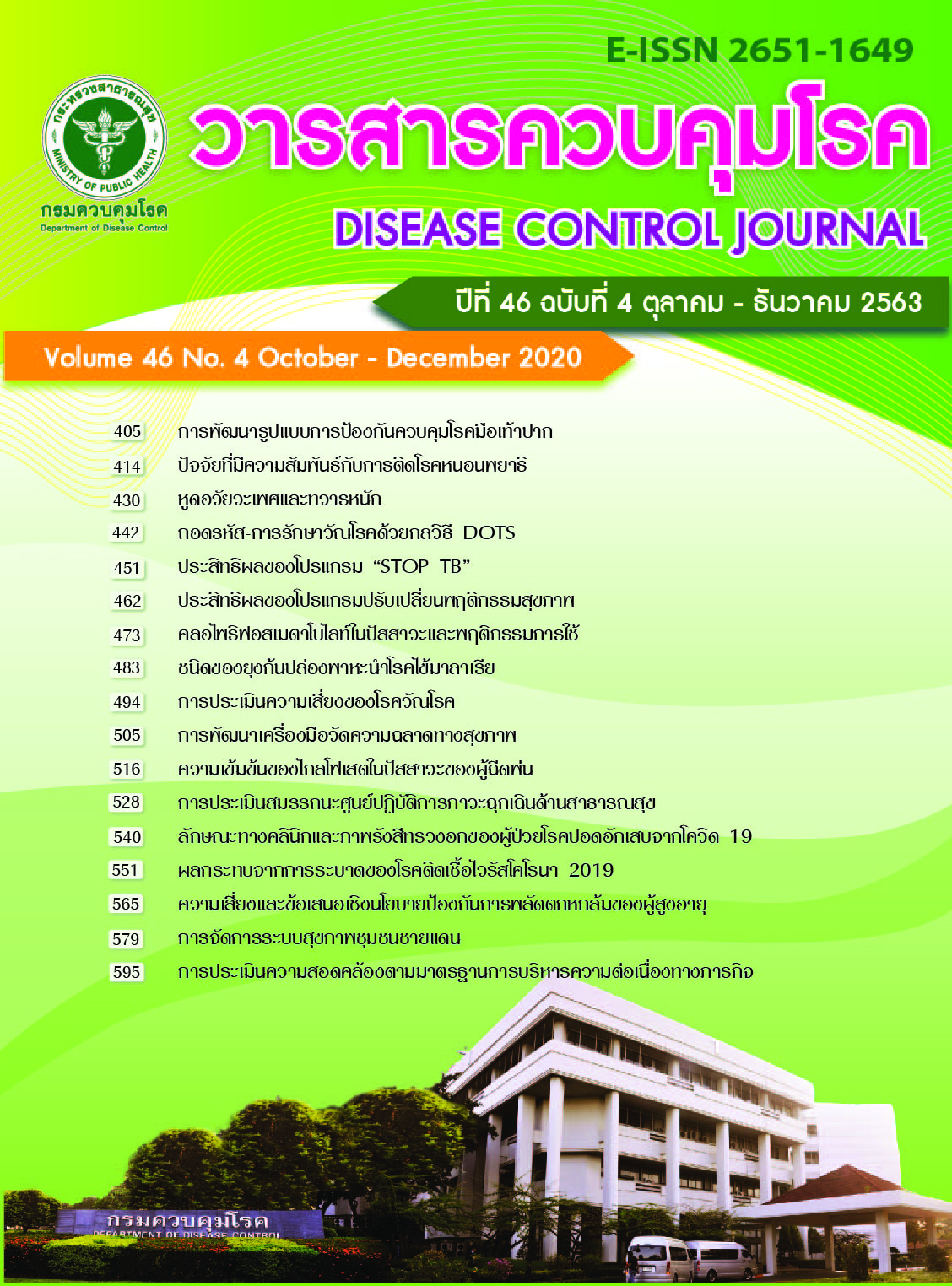Urinary chlorpyrifos metabolite concentrations and chlorpyrifos use behaviors among occupational sprayers in Suphan Buri Province
DOI:
https://doi.org/10.14456/dcj.2020.44Keywords:
chlorpyrifos, urine, TCP, occupational sprayers, biomarkersAbstract
The urinary TCP (3,5,6-Trichloro-2-pyridinol) is widely accepted as the biomarker of chlorpyrifos exposure. This study is a cross sectional study. The objectives are to determine the urinary TCP concentrations in the morning void urine after spraying chlorphyrifos, and work behavior of spraying chlorpyrifos in the occupational sprayers. The subjects consisted of 82 occupational sprayers in Suphanburi Province, Thailand. The subjects were interviewed with questionnaire and urine samples were collected from occupational sprayers in the morning after spraying chlorpyrifos. Urine samples were analyzed with Gas Chromatograph/Mass Spectrometer (GC/ MS).The data were then analyzed using descriptive statistics and Mann Whitney U Test. The study found that TCP in all urine samples (100%) were between 15 to 136,716 µg/g creatinine. In addition, the study found the chlorpyrifos quantity used and behavior of standing under the wind while spraying chlorpyrifos increased the urinary TCP in the morning void urine (p<0.001 and p<0.05), respectively. In conclusion, the amount of chlorpyrifos receives to the body increases with the amount of chlorpyrifos sprayed, number of spraying event and behavior while spraying chlorpyrifos. Therefore, the substitution of chlorpyrifos should be in place, together with organizing the occupational health services in the community to follow up on health surveillance of impact on health of occupational sprayers and local farmers.
Downloads
References
Dwivedi N, Flora SJ. Concomitant exposure to arsenic and organophosphates on tissue oxidative stress in rats. Food Chem Toxicol. 2011;49(5):1152-9.
Office of Agricultural Economics. Quantity and value of pesticide imports 2011-2018 [Internet]. [cited 2019 Oct 24]. Available from: http://www.oae.go.th/view/1/%E0%B8%9B%E0%B8%B1%E0%B8%88%E0%B8%88%E0%B8%B1%E0%B8%A2%E0%B8%81%E0%B8%B2%E0%B8%A3%E0%B8%9C%E0%B8%A5%E0%B8%B4%E0%B8%95/TH-TH. (in Thai)
World Health Organization. WHO recommended classification of pesticides by hazard and guidelines to classification. Geneva: World Health Organization; 2009.
Koshlukova SE, Reed NR. Chlorpyrifos. In: Wexler P, editor. Encyclopedia of Toxicology. 3rd ed. Oxford: Academic Press; 2014. p. 930-4.
Malhotra A, Nair P, Dhawan DK. Efficacy of zinc as a nutritional supplement in ameliorating chlorpyrifos-induced neurotoxicity in rats. J Environ Pathol Toxicol Oncol. 2011;30(3):225-33.
Khokhar JY, Tyndale RF. Rat brain CYP2B-enzymatic activation of chlorpyrifos to the oxon mediates cholinergic neurotoxicity. Toxicol Sci. 2012;126(2):325-35.
Garabrant DH, Aylward LL, Berent S, Chen Q, Timchalk C, Burns CJ, et al. Cholinesterase inhibition in chlorpyrifos workers: Characterization of biomarkers of exposure and response in relation to urinary TCPy. J Expo Sci Environ Epidemiol. 2009;19(7):634-42.
Farahat FM, Ellison CA, Bonner MR, McGarrigle BP, Crane AL, Fenske RA, et al. Biomarkers of chlorpyrifos exposure and effect in Egyptian cotton field workers. Environ Health Perspect. 2011;119(6):801-6.
Khan K, Ismail AA, Abdel Rasoul G, Bonner MR, Lasarev MR, Hendy O, et al. Longitudinal assessment of chlorpyrifos exposure and self-reported neurological symptoms in adolescent pesticide applicators. BMJ Open. 2014;4(3):e004177.
Eaton DL, Daroff RB, Autrup H, Bridges J, Buffler P, Costa LG, et al. Review of the toxicology of chlorpyrifos with an emphasis on human exposure and neurodevelopment. Crit Rev Toxicol. 2008;38 Suppl 2:1-125.
Sunaga M, Yoshida M, Hara I. Metabolism and urinary excretion of chlorpyrifos in rats. Nihon Eiseigaku zasshi. 1989;43(6):1124-9.
Meuling WJ, Ravensberg LC, Roza L, Van Hemmen JJ. Dermal absorption of chlorpyrifos in human volunteers. Int Arch Occup Environ Health. 2005;78(1):44-50.
Phung DT, Connell D, Miller G, Hodge M, Patel R, Cheng R, et al. Biological monitoring of chlorpyrifos exposure to rice farmers in Vietnam. Chemosphere. 2012;87(4):294-300.
Aponso GLM. Exposure and health risk assessment for farmers occupationally exposed to chlorpyrifos in Sri Lanka and drinking water and house dust analysis for chlorpyrifos [master’s thesis]. USA: Oregon State University; 2002.
Alexander BH, Burns CJ, Bartels MJ, Acquavella JF, Mandel JS, Gustin C, et al. Chlorpyrifos exposure in farm families: Results from the farm family exposure study. J Expo Sci Environ Epidemiol. 2006;16(5):447-56.
Atabila A, Phung DT, Sadler R, Connell D, Chu C. Comparative evaluation of chlorpyrifos exposure estimates from whole-body dermal dosimetry and urinary trichloro-2-pyridinol (TCP) methods. Ecotoxicol Environ Saf. 2019;172:439-43.
Barr DB, Angerer J. Potential uses of biomonitoring data: a case study using the organophosphorus pesticides chlorpyrifos and malathion. Environ Health Perspect. 2006;114(11):1763-9.
Singleton ST, Lein PJ, Dadson OA, McGarrigle BP, Farahat FM, Farahat T, et al. Longitudinal assessment of occupational exposures to the organophosphorous insecticides chlorpyrifos and profenofos in Egyptian cotton field workers. Int J Hyg Environ Health. 2015;218(2):203-11.
Callahan CL, Hamad LA, Olson JR, Ismail AA, Abdel-Rasoul G, Hendy O, et al. Longitudinal assessment of occupational determinants of chlorpyrifos exposure in adolescent pesticide workers in Egypt. Int J Hyg Environ Health. 2017;220(8):1356-62.
Downloads
Published
How to Cite
Issue
Section
License
Articles published in the Disease Control Journal are considered as academic work, research or analysis of the personal opinion of the authors, not the opinion of the Thailand Department of Disease Control or editorial team. The authors must be responsible for their articles.






